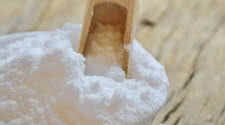Sodium Bicarbonate as an Ergogenic Aid for Exercise

Advanced Nutritional / Supplements Science & Overall Wellness Studies
Sodium bicarbonate, or baking soda, is often suggested as an ergogenic aid, particularly for short, high-intensity exercise. The limiting factor in such exercise is either insufficient muscle glycogen stores or increased muscle acidity due to anaerobic metabolism. Unlike aerobic
metabolism, anaerobic metabolism doesn't rely on oxygen, and it produces the by-product lactic acid. As the acid levels go up, energy producing enzymes become inhibited. This leads to muscular fatigue.
Bicarbonate acts as a buffer to soak up excess acid ions and raise the muscle p1-1. Now, the muscle cell isn't permeable to bicarbonate, but the blood is, and the theory is that by neutralizing the buildup of blood acidity, you cause an increased flow of acid from the muscle.
The scientific studies attempting to test this hypothesis have not been decisive. Some show that taking a dose of sodium bicarbonate equal to 300 milligrams per kilogram of bodyweight does enhance muscle performance and delay fatigue. Other studies, however, find either no effect
or unacceptable side effects, such as nausea and diarrhea. The most recent research, reported in the December '94 issue of Medicine and Science in Sports and Exercise, looked at the effects of sodium bicarbonate on the exercise performance of seven competitive female cyclists.
The cyclists took 300 milligrams per kilogram of bodyweight of either sodium bicarb or sodium chloride, a.k.a. table salt, two hours before exercise.
They then did high-intensity interval exercise on stationary bikes. The results showed no improvement in performance with either substance. Because the scientists conducting this study controlled for the amount of sodium ingested, they suggested that the apparent lack of results
from the bicarb was due to a smaller blood volume expansion. Thus, they believe that past studies showing beneficial effects of sodium bicarb were more a product of diluted blood caused by the sodium water-retaining property than the bicarb.
Sodium bicarbonate has never caught on with bodybuilders, probably because of its high sodium content, which causes water retention. In addition, recent evidence shows that reducing blood acidity may not be advisable during weight training. Increased blood acidity is the cue for
increased growth hormone release during exercise, and neutralizing it via bicarb supplements would inhibit GH release.
More practical buffers would be those that only work intramuscularly, including phosphate, carnosine and creatine phosphate. Creatine in monohydrate form is currently one of the hottest food supplements, and unlike the situation with other suggested ergogenic aids there is some
solid research to prove its efficacy So much of the increased power evident when athletes load creatine may be partially due to its intramuscular buffering capabilities. Glutamine as a Marker of Exercise Stress Another popular food supplement making the rounds in bodybuilding is
the amino acid glutamine. Once considered an obscure, insignificant amino, it has been elevated to stat status in recognition of its role in promoting muscle protein synthesis. For example, two popular whey protein powders boldly state on their cans that they are "glutamine enriched."
Under stressful conditions glutamine exits muscle and is then used as fuel for certain immune cells and cells lining the intestinal tract. When it leaves the muscle cells, however, they get dehydrated. As such they're far more subject to the catabolic effects of stress hormones,
such as cortisol.
Australian scientists recently did a study to determine if glutamine is a useful marker to gauge exercise stress. They used two exercise regimes: In the first seven male subjects exercised off a treadmill at intensities of 0, 30, 60,90 and 120 percent of maximal oxygen uptake, and
in the second seven highly trained athletes did interval sessions twice a day for 10 days, followed by a six-day recovery. The results showed decreased glutamine plasma levels after the 90 and 120 percent maximal oxygen intake exercise. In other words, the higher the exercise
intensity, the greater the glutamine deficit.
Four of five subjects in the highly trained group showed reduced plasma glutamine by the sixth clay, and am of them displayed it by the 11th day. Even so, the rate of glutamine re Undiscovery varied, with two of the subjects' levels still low by the 16th day. This study shows that
measuring glutamine can be a good indicator of not only exercise stress but also the degree of recovery ability after intense exercise.
Although supplemental forms of glutamine are available, you'd have to take 30 to 40 grams a day to get any meaningful effect because most orally ingested glutamine is used as fuel by the cells of the intestine and never gets to the muscles, Other forms of glutamine precursors, such
as 0KG and alpha-ketoglutarate, also are available and may be more cost effective than supplementing with straight glutamine. Unfortunately, there is no research yet to indicate effective doses of these supplements for a healthy, exercising population.